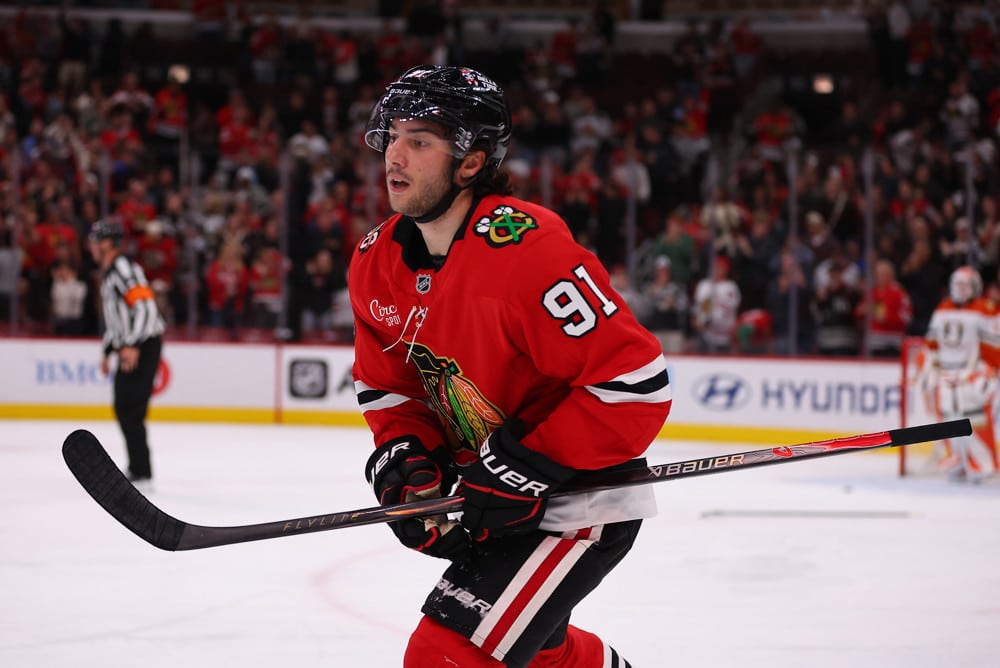
The Chicago Blackhawks aren’t just sneaking wins — they’re earning them. Special teams are delivering, the kids on defense look calm beyond their years, and Connor Bedard has shifted from “future star” to “now.” Add steady goaltending, a veteran-of-the-week boost, and Jeff Blashill’s structure with seven D, and you’ve got a team identity that travels.
1. Power Play: From Struggling to Straight-Up Dangerous
After three weeks of frustration where the Blackhawks sat in the bottom third of the league on the power play, everything flipped. Chicago was sitting around 17.5% not long ago, ranked 21st in the NHL, and the fan base felt the unit looked predictable. Then Jeff Blashill made the moves that changed the temperature of the entire team.
Connor Bedard moved to the right flank, Andre Burakovsky took over the left flank, and Artyom Levshunov replaced Rinzel as the QB. Suddenly the entries became clean, Bedard’s shot threat pulled defenders out of shape, and Bertuzzi became a nightmare in front of the net.
The results speak for themselves. Over their last five games, the Blackhawks have scored six power-play goals, running at 54.5%, one of the hottest stretches in the league. That surge pushed them to 25.5% overall, good for 7th in the NHL, only days after they were sitting near the basement.
This is not luck. It is confidence, structure, and a group that finally trusts its rhythm on the man advantage. When Bedard rips one early, everything opens up. When Burakovsky gains the blue line with speed, the Hawks start in formation instead of chasing the puck. When Levshunov runs the top, pucks arrive on time and shots get through.
The Blackhawks’ power play has become a weapon, and it is a huge reason why they sit at 8-5-3, their best start since 2016.
2. Young blue line and two locked-in goalies
This has become the shock of the season. Chicago leads the entire NHL in 5-on-5 save percentage at 93.4%, and they are doing it with a defense corps that most predicted would struggle. Five of their seven regular defensemen are 24 years old or younger, and after the Seth Jones trade last year, the narrative was that this blue line would need time.
They have changed that storyline fast. The kids defend with tight gaps, they win the middle of the ice, and they protect the crease like they have played 300 games. The structure is helping, but the real anchor is in goal.
Spencer Knight has been one of the best goaltenders in the NHL. His numbers are elite across the board:
• .936 save percentage — third in the NHL
• 2.33 GAA — seventh in the NHL
• 11 starts in 15 games, carrying a 6-3-2 record
• 10 of 11 starts graded as quality starts
That alone is impressive, but the big one is this:
Knight is number one in the entire NHL in Goals Saved Above Expected, sitting at roughly +13.3 GSAX. That stat tells the real story. He is not just playing well. He is outperforming shot quality by a massive margin and lifting the Hawks to wins they would not have had last season.
Arvid Soderblom has backed that up with his own breakout. His 45-save night in Detroit was proof that he can carry pressure and close out games.
3. Connor Bedard is changing the Blackhawks’ identity
Connor Bedard walked into this season with questions hanging around him. People across the league wondered how he would respond after a tough sophomore year. The Blackhawks were young, the matchups were heavy, and some worried that he might need more time before taking that next step.
He has erased every doubt. Through 15 games, Bedard has launched himself into a true breakout, sitting second in the NHL with 25 points and earning Second Star of the Week honors. He is on a career-best eight-game point streak, piling up 7 goals, 11 assists, 18 points, six power-play points, and 30 shots on goal during that stretch. These are not just strong numbers for a young player. These are the numbers of a superstar driving his team.
Bedard has reshaped the Blackhawks’ offensive identity. He attacks with intensity, pushes the pace, and refuses to sit on the perimeter. He goes inside ice, takes contact, and competes in all three zones. The confidence is different. The presence is different. This is a player who understands that he can tilt games.
One of the most encouraging signs is his growth on faceoffs. After sitting at 38.6% over his first two seasons, he is now up to 46.7%. That kind of jump does not happen by accident. It comes from reps, film work, and a player who simply refuses to let a weakness stay a weakness. Bedard wants more, and he is showing it shift after shift.
Most nights, he is pulling the Blackhawks forward. Not only through goals but through the way he plays. He is giving this team a new identity built around speed, skill, and competitiveness. The question will naturally come up: can he force his way into the conversation for Team Canada at the next Winter Olympics? The competition is stacked, but when a 20-year-old is producing like this, you cannot ignore him.
What matters most is the direction. Bedard, along with other young stars like Celebrini and Carlsson, is part of a new wave changing how the NHL looks and feels. For Chicago, he is not just the future of the franchise. He is the core of who they are becoming right now.
4. Blackhawks veterans drive the heartbeat of this team
Chicago’s young core gets the headlines, but the reason this team sits at 8-5-2 is because the veterans refuse to let the group fall off. Every week, one or two vets step forward and steady the game at the exact moment the Hawks need it. A young roster does not survive early-season swings without people who have been through the grind, and Chicago has leaned on those players constantly.
At the start of the season, Teuvo Teravainen, Ryan Donato, and Ilya Mikheyev carried heavy minutes and set the tone. Teravainen and Donato both sit at 11 points, and Mikheyev has been a consistent driver on the forecheck. Those three gave Chicago honest, structured hockey when the young lineup was still finding its rhythm. More than once, a win came directly from one of them making the difference in the third period. Their habits and pace allowed the Hawks to stay in games, survive pushes, and pull out points they would have lost last year.
As October turned into November, two more veterans took the wheel. Tyler Bertuzzi and Andre Burakovsky did not just start producing; they elevated the entire top six. Both are currently tied for second on the team with 14 points, and their play with Bedard is a major reason the power play has exploded. Bertuzzi brings net-front chaos and a relentless compete level. Burakovsky brings patience, puck control, and calm decision-making on entries. Together with Bedard and Levshunov, they transformed a struggling unit into one of the hottest in the league over the last five games.
On the back end, the veteran presence comes in quieter ways but matters just as much. Matt Grzelcyk stabilizes the young defense with clean exits and smart first passes. Connor Murphy handles the minutes, wins battles around the crease, and gives the coaching staff a trustworthy anchor. Their work allows the young defensemen to play fast without being overwhelmed by matchups.
This is the biggest difference from the past two seasons. Chicago is no longer relying on one line or one star. Bedard and Knight are leading, but the veterans supply the backbone, the experience, and the situational maturity that good teams need. The kids drive the excitement; the vets drive the consistency.
The balance is working. It is one of the biggest reasons the Blackhawks are playing meaningful, competitive hockey again.
5. Jeff Blashill’s system is holding everything together
Jeff Blashill has quietly become one of the biggest reasons Chicago is playing structured, competitive hockey again. He didn’t come in trying to copy another team’s playbook. He brought a system that fits this roster perfectly at this stage of the rebuild.
His most visible stamp is the 11 forwards and 7 defensemen setup. Almost no one in the NHL uses it, but Blashill does because it works for this group. With so many young defensemen, spreading the minutes matters. No one gets overexposed. No one gets left behind. It gives Levshunov, Rinzel, Crevier, Vlasic, and Kaiser real NHL reps without asking them to carry veteran workloads. It is simple coaching logic that pays off every night.
The extra defenseman also gives Blashill more flexibility on special teams. He can rotate PK pairs, adjust PP quarterbacks, and manage matchups more effectively. Running one less forward opens the door to double-shift Bedard and tilt the ice at key moments. Opponents can’t lock onto one line for long stretches because Blashill constantly changes the look.
The defensive structure has improved dramatically. The Hawks close faster, protect the slot better, and push plays outside. Breakouts are cleaner. There are fewer panic touches, fewer blown coverages, and more trust between the goalie and the skaters. That is coaching. Combine that with the league’s best 5-on-5 save percentage and you see a system that supports both young defensemen and elite goaltending.
Most importantly, the players know exactly what is expected of them. Young guys are allowed to grow without getting buried. Veterans know their roles. Everyone feels part of something that makes sense. When a locker room believes in a system, you can feel it in the consistency.
Chicago still has a long road ahead, but Blashill has given the Blackhawks a real identity: structured, connected, competitive. That foundation is a major reason why this team is not just surviving games anymore. They are controlling them.
Bonus: The rookies and young prospects shape new Blackhawks identity
Chicago is not just winning because of Bedard, Knight, or the veterans. The real long-term excitement comes from the rookies and young prospects who are already making an impact. This is the new wave of the Blackhawks, and they are changing how the team plays every night.
Artyom Levshunov has become the face of the youth movement on defense. With 9 points in his first 16 games, he leads all Blackhawks defensemen and already looks like a top-pair presence. His poise, breakout ability, and confidence on the power play have transformed the blue line. He does not play scared. He plays like he belongs.
Sam Rinzel, Ryan Greene, and Colton Dach are adding their own sparks. Rinzel’s skating and passing give the Hawks a modern puck-mover who can create offense from the back end. Greene and Dach bring pace, energy, and reliable minutes that stabilize the bottom six. Each one fills a different need, but together they give the roster real depth from players still barely breaking into the league.
Louis Crevier has taken a major step too. His size is obvious, but his reads, positioning, and defensive awareness are catching up quickly. He sits at 6 points, tied for second among Blackhawks defensemen, and he is earning the trust of the coaches shift by shift.
Oliver Moore is the newest punch of energy. His speed changes shifts instantly, and he gives Chicago a different look down the middle. When he is in the lineup, the Hawks play faster and stretch the ice north-south. That is exactly the type of identity this team wants.
You can’t talk about the young core without mentioning Alex Vlasic and Wyatt Kaiser. Vlasic continues to grow into a true shutdown guy, and Kaiser brings clean puck movement and mobility that fits perfectly with Blashill’s system. These two were part of the early stages of the rebuild, but now they are leading the next wave.
This entire youth group is the reason people are starting to talk differently about the Blackhawks. It is no longer a team simply waiting for prospects. The prospects are here. They are contributing. They are building the new Chicago identity alongside Bedard.
The combination of star talent, veteran leadership, elite goaltending, and a wave of rookies playing meaningful minutes is why this start feels real. It is not one piece. It is not one miracle run. It is the foundation of something bigger.
Connecting the Present to the Past: Duncan Keith Enters the Hall of Fame
As Chicago pushes forward with a new identity, the Hockey Hall of Fame reminded everyone what the gold standard looks like. Duncan Keith, one of the greatest defensemen in Blackhawks history, was officially inducted into the Hall of Fame last night. His career is more than a list of trophies. It is a blueprint for exactly what this young roster is trying to build.
Keith’s résumé is untouchable.
• Three-time Stanley Cup Champion (2010, 2013, 2015)
• Conn Smythe Trophy as playoff MVP in 2015
• Two-time Norris Trophy winner (2010, 2014)
• Over 1,200 NHL games
• Career 646 points, including eight seasons with 40+
• 26:00+ average TOI in his prime, the definition of a workhorse
• Olympic Gold Medalist (2010, 2014)
When Chicago needed stability, he delivered. When they needed minutes, he played half the game. When they needed leadership, he never took a shift off. He was elite in transition, he defended like a machine, and he elevated every partner he ever played with.
For today’s Blackhawks, this is more than nostalgia. This is inspiration.
Young defensemen like Levshunov, Kaiser, Rinzel, Crevier, and Vlasic are the new foundation of the franchise. They are skilled. They are talented. They are learning how to win. Watching Keith get honored shows them what a championship-caliber Chicago defenseman looks like. Not just the points or the skating, but the standard. The preparation. The commitment. The willingness to handle the toughest minutes and the biggest moments.
Keith’s induction also matters for the fanbase. It reminds Chicago that this rebuild is not aimless. The franchise has built championships before through drafting and developing its own stars. It happened with Keith, Seabrook, Kane, Toews, Hjalmarsson, and the core that brought the city three Cups in six years. Now the franchise is trying to do it again, this time around Bedard, Knight, and a new wave of youth.
The ceremony showed what excellence looks like. The young Blackhawks are chasing that. They won’t be Duncan Keith, but they can learn from his example, his style, and his attitude. Keith set the bar. This new generation wants to reach it.
If they do, Chicago won’t just be rebuilding. They will be restoring a legacy.
A Centennial Season With a New Identity
The Chicago Blackhawks are not a finished product. They are a young, hungry group learning how to win, how to compete, and how to build an identity that can carry them into the next decade. What makes this start so impressive is how balanced it has been. The power play is finally dangerous. The save percentage is elite. Bedard is performing like a true star. Veterans are stepping up every week. Blashill’s structure is holding everything together. The rookies and prospects are pushing the pace. This is what real progress looks like.
All of it hits even harder because this is the Blackhawks’ Centennial season. One hundred years of hockey in Chicago. One hundred years of legends, heartbreaks, banners, and memories. A century of names that shaped the sport. Now this new group gets its chance to write the next chapter.
Seeing Duncan Keith enter the Hall of Fame during this season adds even more meaning. Keith and the dynasty era showed Chicago what excellence looks like. They built a culture based on preparation, compete level, sacrifice, and belief. That legacy is the standard, and it still echoes through the organization today.
This young team isn’t at the finish line, but they are moving in the right direction. They are playing meaningful hockey, growing with confidence, and pushing each other every night. The fanbase can finally see a path forward. The players can feel the momentum. The league is starting to pay attention.
If this is how Chicago is starting its Centennial year, then the next era of Blackhawks hockey won’t just be a rebuild. It will be a rise.
KEEP READING:
Blackhawks Weekly Recap: (Week 1)
Blackhawks Weekly Recap (Week 2)
Blackhawks Weekly Recap (Week 3)
Blackhawks Weekly Recap (Week 4)
Blackhawks October Report Card
Looking for discussion? Check out our forums section and weigh in on what’s happening around the NHL!




